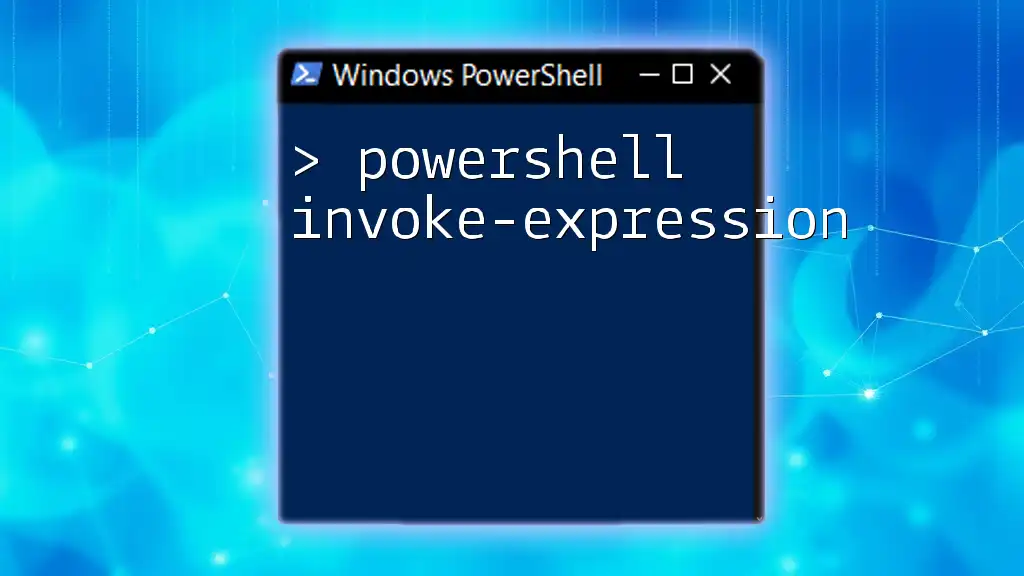The `-ine` parameter in PowerShell is used with the `Select-String` cmdlet to filter and return specific lines from text input that match a given pattern.
Here's a code snippet demonstrating how to use it:
Get-Content 'example.txt' | Select-String -Pattern 'searchTerm' -CaseSensitive -SimpleMatch -ine
What is PowerShell `-ine`?
The `-ine` parameter in PowerShell allows users to access specific lines of input from a stream where data is being processed, making it a useful tool for filtering and managing output effectively. This parameter is primarily used in cmdlets that handle string inputs or files, allowing you to extract a specific line index from the result.
When to Use `-ine`
Understanding when to utilize the `-ine` parameter can greatly simplify your scripts. It's particularly beneficial in scenarios where you have large outputs and only need a certain few lines. It can save time, effort, and enhance script performance.

Basics of PowerShell Pipeline and Its Parameters
Understanding the PowerShell Pipeline
The PowerShell pipeline is fundamentally how PowerShell passes data from one cmdlet to another. By utilizing the pipeline, you can chain multiple commands together seamlessly, allowing for powerful and efficient scripting.
Common Pipeline Parameters
Along with `-ine`, there are other useful pipeline parameters, such as `-out` and `-filter`. Understanding how these parameters interact will help you leverage the full power of PowerShell when processing data.

Using PowerShell `-ine` for Filtering Output
Syntax of the `-ine` Parameter
The basic syntax for `-ine` is straightforward. It typically follows the primary command and is utilized to specify which lines are of interest. The typical structure looks like this:
Get-Content "file.txt" -ine LineIndex
Here, `LineIndex` represents the specific line number you wish to retrieve from the file.
Example of Using `-ine`
Here’s a practical example showcasing how to leverage the `-ine` parameter effectively:
Get-Content "example.txt" -TotalCount 10 -Skip 5 -ine
In this command, `Get-Content` reads the contents of `example.txt`, where `-TotalCount 10` returns the first ten lines. The `-Skip 5` portion omits the first five lines, and finally, `-ine` helps identify which specific line to show from the remaining output.
The result will be one of the lines in the output after skipping the initial five, allowing you to focus on the relevant data instantly.

Advanced Usage of `-ine` with Other Cmdlets
Combining `-ine` with Select-String
Using `-ine` can be particularly useful when combined with the `Select-String` cmdlet to narrow down search results in a file. For example:
Get-Content "log.txt" | Select-String "Error" -ine
This command searches through `log.txt` for any line containing the word "Error". The `-ine` parameter ensures you are only getting specific lines that meet the criteria, streamlining your output and making it easier to diagnose issues.
Using `-ine` with Format-List
Another way to enhance the utility of `-ine` is in conjunction with `Format-List`:
Get-Process | Format-List -ine Name, CPU
In this instance, you’re essentially addressing a list of processes. By using `-ine`, you retrieve a formatted list that clearly displays the Name and CPU usage of processes. This not only improves readability but also helps focus on just the essential data you wish to monitor.

Best Practices for Using `-ine`
Performance Considerations
While using `-ine` can be beneficial, it’s crucial to consider the performance implications. In scenarios involving large datasets, `-ine` can speed up processing times; however, avoid using it excessively or unnecessarily, as this could lead to confusion in your scripts and a potential decrease in performance.
Readability and Maintainability
Script readability is paramount in any programming or scripting endeavor. When employing the `-ine` parameter, remember to name your variables meaningfully and comment your code adequately. This practice makes it easier to read and maintain, particularly if you, or others, revisit it in the future.

Troubleshooting Common Issues with `-ine`
Common Errors and Solutions
While working with `-ine`, you may encounter several common errors:
-
Invalid line number: This happens if the specified line number does not exist in the output. This can be resolved by confirming that the line index is within bounds.
-
Empty output: If no content matches your criteria when using `Select-String`, this could lead to unexpected empty results. Verify if the searching term exists within the text or file.
Debugging Techniques
Debugging scripts that utilize `-ine` requires a keen eye for detail. One effective method includes using:
Write-Host "Debugging output at line index: $LineIndex"
Including `Write-Host` within your scripts allows you to print out current variable states, helping track where things might be going wrong.

Conclusion
The `-ine` parameter in PowerShell is an incredibly effective tool that can enhance your scripting capabilities. By mastering its use, you can streamline output, improve performance, and make your scripts more readable. Dedicating time to practice and understand this parameter will significantly contribute to your overall proficiency in PowerShell scripting.

Additional Resources
For further reading and resources:
- Explore the official Microsoft PowerShell documentation.
- Join online communities and forums to connect with other PowerShell enthusiasts.
- Seek out books and tutorials that delve deeper into the intricacies of PowerShell commands, including parameters like `-ine`.
By diving into these materials, you will equip yourself with the knowledge necessary to take full advantage of PowerShell's robust capabilities.



















